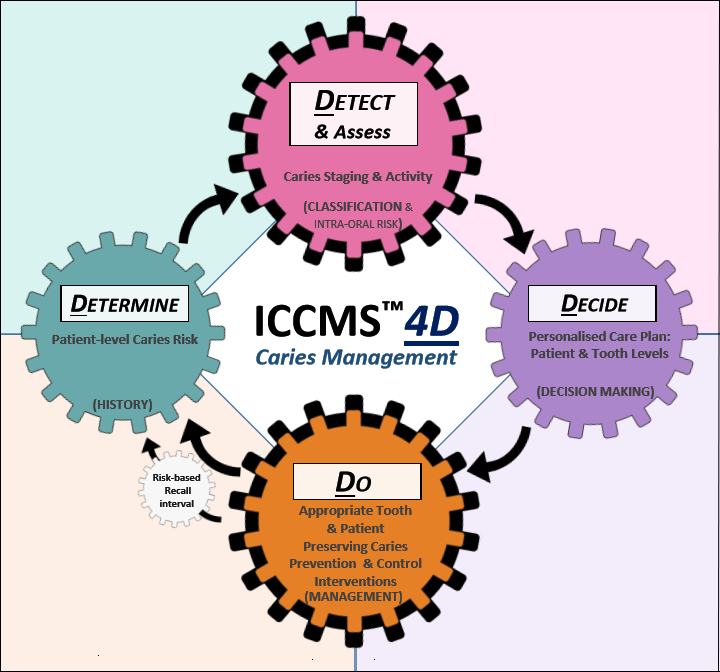ICCMS™
Prevents new lesions, arrests existing lesions, and preserves tooth structure of lesions that need operative care. Since 2018, ICCMS™ in Practice is delivered by CariesCare International
International Caries Classification and Management System (ICCMS™)
The ICCMS™ is a health outcomes focused system that aims to maintain health and preserve tooth structure. Staging of the caries process and activity assessment is followed by risk-adjusted preventive care, control of initial non-cavitated lesions, and conservative restorative treatment of deep dentinal and cavitated caries lesions.
There are four elements in the ICCMS™, the two key aspects are:
1 Classification - Caries Staging & Activity Assessment: this comprises (i) staging of caries lesion severity (‘initial’/’moderate’/’extensive’) and (ii) caries activity assessment (likelihood of progression or arrest/reversal of lesions: ‘active’/’inactive’). (Note that during the intraoral assessment phase information is also collected on oral risk factors; e.g. oral hygiene, dry mouth).
2 Management - Personalised Caries Prevention, Control & Tooth Preserving Operative Care: The dental team, together with the patient, devise a Personalised Caries Care Plan to manage the caries risk status of the patient as well as managing caries lesions appropriately. (i) Management of the risk status is based on both home care advice, as well as clinical activities; those with low risk getting general information on how to maintain teeth as sound, those with moderate and high risk with increasing focus on behaviour changes and short periods between recalls to the clinic. (ii) The management of the lesions is related to the diagnosis of the individual lesions: ‘initial’ active lesions in general are managed with non-operative care (NOC) whilst moderate/extensive lesions are in general managed operatively with tooth preserving operative care (TPOC).
In order to devise an optimal Personalised Caries Management Plan, two other elements are also needed (please note that the chronological sequence and the method of integration of patient and clinical information may vary according to local preferences):
3 History - Patient-level Caries Risk Assessment: collation of risk information at the patient level (to be integrated with clinical and tooth level information).
4 Decision Making - Synthesis and Diagnoses: (i) classification of individual lesions combining information about their stage and activity (e.g. ‘initial’ active lesion), and (ii) an overall caries risk likelihood status combining information about presence/absence of active lesion/s and patient’s risk (‘low’, ‘moderate’ or ‘high’ risk of getting future caries and/or of lesion progression). [For more information see our elearning]
